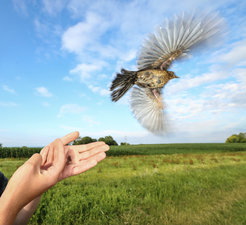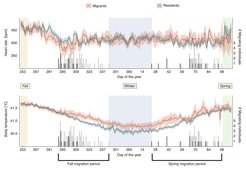Do birds save energy by migrating?
Study disproves the common theory that migration leads to overall energy savings
Millions of birds migrate every year to escape winter, but spending time in a warmer climate does not save them energy, according to research by the Max Planck Institute of Animal Behavior (MPI-AB). Using miniaturized loggers implanted in wild blackbirds, scientists recorded detailed measurements of heart rate and body temperature from birds every 30 minutes from fall to the following spring—the first time the physiology of free flying birds has been quantified continuously at this scale over the entire wintering period. The data offer unprecedented insights into the true energetic costs of migrant and resident strategies and reveal a previously unknown mechanism used by migrants to save energy prior migration. The findings are published on September 18 in the journal Nature Ecology & Evolution.

“We never expected to discover that birds gain no overall energy advantage by escaping cold winters,” says Nils Linek, a first author of the study and a researcher at MPI-AB. “It was a longstanding textbook assumption that animals spend less energy by migrating to warmer places, but our findings have shown that these savings don’t add up. Rather, the energetics of migration is far more complex and interesting than theory predicted.”
Animal migration is a spectacular example of how animals adapt to changing seasons. Yet the ultimate question—why?—has remained a scientific puzzle because of the barriers to studying the physiology of free-living animals over long periods. In the new paper, researchers from MPI-AB and Yale University have unlocked an important piece of that puzzle by deploying sensors that measured the energy expenditure of blackbirds for the complete annual migration and then pairing the physiological data with modelling to calculate the predicted energetic costs of thermoregulation.
Data from the sensors showed that migrating blackbirds conserved considerable energy in preparation for migration by decreasing their metabolism three weeks before departure, potentially dwarfing the energy costs of migratory flights. “They are essentially turning down their internal thermostat, allowing them to save energy for the journey ahead,” says Linek. Yet when the migrants are in the warmer wintering areas, they do not appear to decrease total daily energy expenditure.
“This was not what we anticipated,” said Scott Yanco, co-first author on the study from the Yale Center for Biodiversity and Global Change. “The energy modeling we did in the study predicted that migration should definitely create an energy surplus because of the substantially reduced cost of keeping warm in milder climates.”
So where did this theoretical energy surplus of migrants go? Says Linek: “We can only speculate at this point, but we suggest that there may be other physiological adaptations or hidden costs that migrant blackbirds face in their milder overwintering sites. These might include factors such as the need to maintain vigilance in new environments, immune functions or unknown stressors that offset the thermal advantage they should have experienced.”

The team worked with blackbirds in southern Germany. Like many populations throughout Europe, German blackbird populations are “partially migratory”, which means that some individuals migrate southwards to spend winter in milder regions like Spain and France, while others remain as residents on the colder breeding grounds all year. The researchers surgically implanted miniature heart rate and body temperature loggers into 120 wild birds; and the loggers recorded data every 30 minutes from September up to the following May when the devices were removed. The team also tracked the birds with radio transmitters, which signaled when the migratory individuals departed Germany in September and returned in March and April the following year. The researchers analyzed data from the loggers, totaling around 1 million data points, to compare how body temperature and heart rate differed between migrant and resident blackbirds.

“Using physiological data we were able to see with incredible detail how birds undertake and experience migration, from the migratory flight itself, to how they recovered afterwards, to what they did over winter,” says Tamara Volkmer, a co-author on the study and MPI-AB doctoral student. “By recording long-term, detailed energy measurements of migrants, we could glimpse the hidden costs of their impressive round trip.”
The study’s findings suggest that the risks and challenges of migration are not offset by energy savings in warmer climates, opening up new questions about the evolutionary drivers behind migration more broadly. “This could have implications for our understanding of migration and its underlying mechanisms across different bird species,” says Linek.
The study also has implications for predicting how species might respond to future climate scenarios, the authors say. Senior author Jesko Partecke, a group leader at MPI-AB who has been studying blackbird migration for two decades, says: “Understanding the physiological underpinnings of migration means that we can better forecast which species may adapt, which may alter their migratory patterns, and which may face greater risks as the world continues to warm.”














